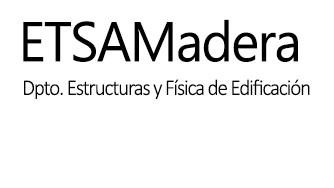Author: Majano Majano, A
Supervisor: Fernández Cabo, J.L.
University: Higher Tech. School of Architecture of Madrid (ETSAM) | Tech. University of Madrid (UPM)
Abstract
Heat-treated wood is modified wood by a high-temperature thermal process which provides greater dimensional stability and durability without adding harmful chemicals to the environment. It has been mainly applied to softwoods due basically to economic reasons. The most common use is outdoors or in high humidity environments, for non-structural elements, furniture, etc.
The present Thesis studies the feasibility of heat-treated hardwoods for structural uses, in particular ash (Fraxinus excelsior L) and beech (Fagus sylvatica L). To this end and considering that the heat treatment modifies the internal structure of the wood resulting in a new material, experimental and numerical studies are performed for its characterization. This research is developed under the Fracture Mechanics approach due to the loss of strength and the increase in brittleness of the material, especially in tension perpendicular to the grain. Likewise, it includes a collection of the bases, foundations and methodologies of this theory applied to untreated wood and other materials due to the lack of such studies in heat-treated wood.
In addition, studies for the mechanical characterization of the material are performed in order to determine the elastic properties considering an orthotropic model. This work is necessary in the research of the fracture behaviour. It led to the development of a new test method for multiparameter determination by using just a single specimen, providing much more robust results than those obtained with conventional test methodology.
Based on this research, and considering the limitations of strength and brittleness, and the questionable applicability of existing standards for untreated wood, it is recommended not to use intense heat treatments on primary structural elements. The application to secondary elements is proposed, so that a possible collapse does not involve a loss of overall reliability of the structure. The feasibility of an innovative and ecological sandwich panel for façades exposed to wind loads, composed by heat-treated wood faces and insulating wood fiberboard with structural function in the core, is studied.
This investigation was developed within the European R&D project “Holiwood”, Holistic implementation of European thermal treated hardwood (TMT) in the sector of construction industry and noise protection by sustainable, knowledge-based and value added products, of the Sixth Framework Program.
